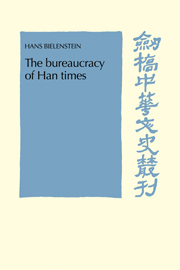Book contents
- Frontmatter
- Contents
- List of tables
- Preface
- Chronological table of emperors
- Abbreviations
- 1 The sources
- 2 The central administration
- 3 The local administration
- 4 The army
- 5 The salaries of the officials
- 6 Civil service recruitment
- 7 Power in government
- 8 Conclusion
- Notes
- Appendix: Official titles of the Han dynasties, Chinese–English
- Quoted literature
- Index
2 - The central administration
Published online by Cambridge University Press: 04 August 2010
- Frontmatter
- Contents
- List of tables
- Preface
- Chronological table of emperors
- Abbreviations
- 1 The sources
- 2 The central administration
- 3 The local administration
- 4 The army
- 5 The salaries of the officials
- 6 Civil service recruitment
- 7 Power in government
- 8 Conclusion
- Notes
- Appendix: Official titles of the Han dynasties, Chinese–English
- Quoted literature
- Index
Summary
All Han officials, whether belonging to the central or local administrations, were ranked on an arbitrary scale. Each man's place on it depended solely on his current office, not on his bureaucratic seniority. The scale must originally have expressed the salary in kind which was due to the officeholder. It ceased to do so and became simply a tool for the ranking of office and their incumbents, and for the determination of privileges and protocol. Salaries were fixed in relation to the scale, in the sense that these increased (although not proportionately) with each higher step. HS 19A: sporadically, and the HHS treatise, more fully, record the ranks of offices, providing an overview not only of the vertical chains of authority but also of the horizontal levels of status. Sixteen of the ranks are identified by the ancient measure of shih, which here stands for capacity and therefore should be translated as ‘bushel’. Below the sixteen ranks, there existed two further ranks which were not expressed in shih:
10,000 shih
Fully 2000 shih
2000 shih
Equivalent to 2000 shih
1000 shih
Equivalent to 1000 shih
600 shih
Equivalent to 600 shih
400 shih
Equivalent to 400 shih
300 shih
Equivalent to 300 shih
200 shih
Equivalent to 200 shih
100 shih
Equivalent to 100 shih
Officials Whose Salaries Are in Terms of Tou
Accessory Clerks
- Type
- Chapter
- Information
- The Bureaucracy of Han Times , pp. 4 - 89Publisher: Cambridge University PressPrint publication year: 1980



